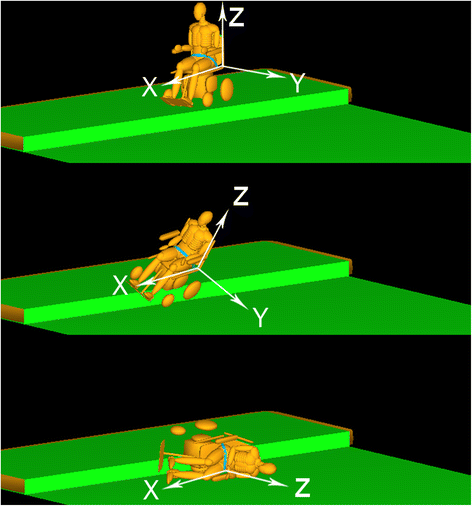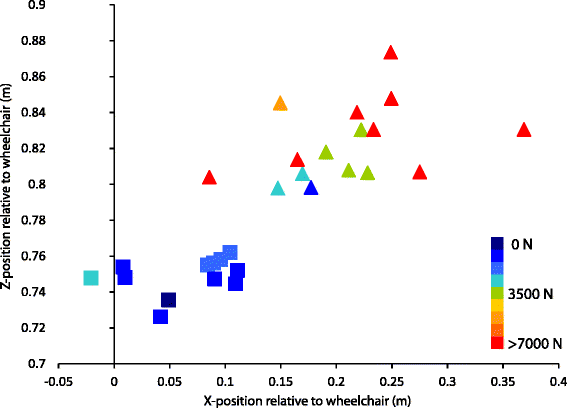The dynamics of electric powered wheelchair sideways tips and falls: experimental and computational analysis of impact forces and injury
- PMID: 26935331
- PMCID: PMC4776350
- DOI: 10.1186/s12984-016-0128-7
The dynamics of electric powered wheelchair sideways tips and falls: experimental and computational analysis of impact forces and injury
Abstract
Background: To reduce the occurrence of wheelchair falls and to develop effective protection systems, we aimed to quantify sideways tip and fall dynamics of electric power wheelchairs (EPWs). We hypothesized that driving speed, curb height and angle of approach would affect impact forces and head injury risk for wheelchair riders. We further expected that fall dynamics and head injury risk would be greater for unrestrained riders compared to restrained riders.
Methods: Sideways wheelchair tip and fall dynamics were reconstructed using a remotely operated rear wheel drive EPW and a Hybrid III test dummy driving at different approach angles (5 to 63°) over an adjustable height curb (0.30 to 0.41 m) at speeds of 0.6-1.5 m/s. Rigid body dynamics models (Madymo, TASS International, Livonia, MI) were developed in parallel with the experiments to systematically study and quantify the impact forces and the sideways tip or fall of an EPW user in different driving conditions.
Results: Shallower approach angles (25°) (p < 0.05) and higher curbs (0.4 m) (p < 0.05) were the most significant predictors of tipping for restrained passengers. Unrestrained passengers were most affected by higher curbs (0.4 m) (p < 0.005) and fell forward from the upright wheelchair when the approach angle was 60°. Head impact forces were greater in unrestrained users (6181 ± 2372 N) than restrained users (1336 ± 827 N) (p = 0.00053). Unrestrained users had significantly greater head impact severities than restrained users (HIC = 610 ± 634 vs HIC = 29 ± 38, p = 0.00013) and several tip events resulted in HICs > 1000 (severe head injury) in unrestrained users.
Conclusions: Sideways tips and forward falls from wheelchairs were most sensitive to curb height and approach angle but were not affected by driving speed. Sideways tips and falls resulted in impact forces that could result in concussions or traumatic brain injury and require injury prevention strategies. Seat belts eliminated the risk of falling from an upright chair and reduced head impact forces in sideways wheelchair tips in this study; however, their use must be considered within the ethical and legal definitions of restraints.
Figures




Similar articles
-
Manual wheelchair downhill stability: an analysis of factors affecting tip probability.J Neuroeng Rehabil. 2018 Nov 6;15(1):95. doi: 10.1186/s12984-018-0450-3. J Neuroeng Rehabil. 2018. PMID: 30400911 Free PMC article.
-
Tips and falls during electric-powered wheelchair driving: effects of seatbelt use, legrests, and driving speed.Arch Phys Med Rehabil. 2003 Dec;84(12):1797-802. doi: 10.1016/s0003-9993(03)00467-2. Arch Phys Med Rehabil. 2003. PMID: 14669186
-
Forces, moments, and acceleration acting on a restrained dummy during simulation of three possible accidents involving a wheelchair negotiating a curb: comparison between lap belt and four-point belt.Am J Phys Med Rehabil. 1997 Sep-Oct;76(5):370-7. doi: 10.1097/00002060-199709000-00004. Am J Phys Med Rehabil. 1997. PMID: 9354490
-
Review of the use of physical restraints and lap belts with wheelchair users.Assist Technol. 2007 Summer;19(2):94-107. doi: 10.1080/10400435.2007.10131868. Assist Technol. 2007. PMID: 17727076 Review.
-
Wheelchair-related falls: current evidence and directions for improved quality care.J Nurs Care Qual. 2005 Apr-Jun;20(2):119-27. doi: 10.1097/00001786-200504000-00006. J Nurs Care Qual. 2005. PMID: 15839290 Review.
Cited by
-
Evaluation of Power Wheelchair Dynamic Suspensions for Tip Prevention in Non-ADA Compliant Surfaces.Arch Phys Med Rehabil. 2023 Dec;104(12):2043-2050. doi: 10.1016/j.apmr.2023.05.016. Epub 2023 Jun 16. Arch Phys Med Rehabil. 2023. PMID: 37329969 Free PMC article.
-
In vivo soft tissue compressive properties of the human hand.PLoS One. 2021 Dec 13;16(12):e0261008. doi: 10.1371/journal.pone.0261008. eCollection 2021. PLoS One. 2021. PMID: 34898632 Free PMC article.
-
Impact forces in backward falls: Subject-specific video-based rigid body simulation of backward falls.Proc Inst Mech Eng H. 2023 Nov;237(11):1275-1286. doi: 10.1177/09544119231207653. Epub 2023 Nov 16. Proc Inst Mech Eng H. 2023. PMID: 37969107 Free PMC article.
-
Manual wheelchair downhill stability: an analysis of factors affecting tip probability.J Neuroeng Rehabil. 2018 Nov 6;15(1):95. doi: 10.1186/s12984-018-0450-3. J Neuroeng Rehabil. 2018. PMID: 30400911 Free PMC article.
-
Numerical investigation of the rider's head injury in typical single-electric self-balancing scooter accident scenarios.J R Soc Interface. 2022 Sep;19(194):20220495. doi: 10.1098/rsif.2022.0495. Epub 2022 Sep 21. J R Soc Interface. 2022. PMID: 36128701 Free PMC article.
References
-
- Kaye HS, Kang T, LaPlante MP. Mobility device use in the United States. National Institute on Disability and Rehabilitation Research. San Francisco, CA: US Department of Education; 2000.
-
- Gaal RP, Rebholtz N, Hotchkiss RD, et al. Wheelchair rider injuries: causes and consequences for wheelchair design and selection. J Rehabil Res Dev. 1997;34(1):58–71. - PubMed
Publication types
MeSH terms
LinkOut - more resources
Full Text Sources
Other Literature Sources
Medical

